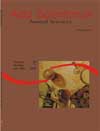<b>Zinc and spray dried alcohol yeast as pronutrient for Nile tilapia fingerlings (<em>Oreochromis niloticus</em> L.)</b> - DOI: 10.4025/actascianimsci.v26i2.1862
Abstract
This research aimed to evaluate spray dried alcohol yeast (Saccharomyces cerevisiae) and zinc (zinc oxide) as pronutrient in initial diet for Nile tilapia (Oreochromis niloticus L.). The experimental diets, isoproteic (30.00%DP) and isoenergetic (3200kcal DE/kg diet), were supplemented with three yeast levels (0.50, 1.00 and 2.00%) and three zinc levels (150, 300 and 600mg/kg). An additional diet with no pronutrient was used. The experiment was a factorial 3 x 3 (yeast levels and zinc) plus an additional treatment (control) and four replications in completely randomized block design. Weight gain, apparent feed conversion, specific growth rate, protein efficiency rate, and apparent digestibility coefficients for dry matter, crude protein, total lipid and gross energy of experimental diets were analyzed. The spray dried alcohol yeast and zinc acted as pronutrient for Nile tilapia fingerlings and the levels of 1.00% of yeast and 300mg Zn/kg diet, presented better responses on growth performance and on the apparent digestibility coefficient. There was a positive interaction between yeast levels and zinc on the weight gain, apparent feed conversion and apparent digestibility coefficient of the dry matter, total lipid and gross energy.Downloads
Download data is not yet available.
Published
2008-04-09
How to Cite
Hisano, H., Pezzato, L. E., Barros, M. M., Freire, E. de S., Gonçalves, G. S., & Ferrari, J. E. C. (2008). <b>Zinc and spray dried alcohol yeast as pronutrient for Nile tilapia fingerlings (<em>Oreochromis niloticus</em> L.)</b> - DOI: 10.4025/actascianimsci.v26i2.1862. Acta Scientiarum. Animal Sciences, 26(2), 171-179. https://doi.org/10.4025/actascianimsci.v26i2.1862
Issue
Section
Animal Science
DECLARATION OF ORIGINALITY AND COPYRIGHTS
- I Declare that current article is original and has not been submitted for publication, in part or in whole, to any other national or international journal.
The copyrights belong exclusively to the authors. Published content is licensed under Creative Commons Attribution 4.0 (CC BY 4.0) guidelines, which allows sharing (copy and distribution of the material in any medium or format) and adaptation (remix, transform, and build upon the material) for any purpose, even commercially, under the terms of attribution.
Read this link for further information on how to use CC BY 4.0 properly.
0.9
2019CiteScore
29th percentile
Powered by 








































